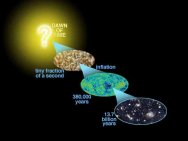Astrophysics
suggests that 13,700,000,000 years ago there was a big bang; After
some billion years, the cloud of interstellar dust began condensing due to the
forces of mass attraction into a large ball of gas (our sun), and smaller lumps
of miscellaneous debris (the planets including Earth). The sun is still primarily
comprised the light elements hydrogen and helium, which, by the way, still comprise
some 99.9% of the mass in the universe. The condensation produced tremendous energy,
and things were very hot -- too hot on earth for water molecules to condense. Over
time, say 5,000,000,000 years ago the earth began to cool, molten minerals forming
rock at the crust. Earth's original atmospheric was mainly hydrogen and helium
was lost to space. Volcanic activity yielded steam, carbon dioxide, nitrogen and
lesser other molecules that eventually formed a secondary atmosphere. Water condensed
forming oceans and lakes. The genesis of life is thought to have occurred by means
of chemical reactions in the atmosphere followed by reactions in the great mother
of life - the sea. | |||||||
|
Fossil
Museum Navigation:
Home Geological Time Paleobiology Geological History Tree of Life Fossil Sites Fossils Evolution Fossil Record Museum Fossils |


